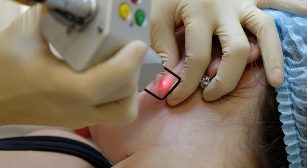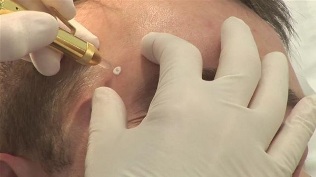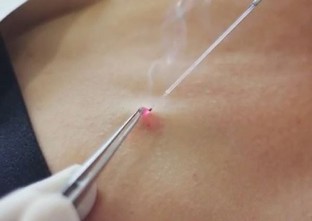
Laser removal of neoplasms is a very common and effective procedure that helps to get rid of unwanted growths. This is a relatively new method that appeared in the medical arsenal a long time ago, but has already proven its superiority with other removal methods. The precursors to laser destruction were cleaning using liquid nitrogen, electricity, or a scalpel. All this can cause a lot of discomfort to the patient, and laser removal shows high results with painless intervention.
Why delete
Papillomas of various shapes and sizes are generally benign neoplasms. They are localized in the mucous membranes of the user or his skin. The main reason for their appearance is the action of human papillomavirus, which is mostly sexually transmitted.
Deleting these collections does several things at once:
- Aesthetic correction.A patient who is growing up may be worried that others will pay too much attention to them. For this reason, although a person does not pose a threat to his growth, he may feel insecure and anxious.
- Injury prevention.If the growth is in a traumatic area where the patient is constantly touched, this protrusion may cause the part to separate. In addition, when trying to cover a papilloma with clothing, there may be a problem such as rubbing the affected area. It is fraught with papilloma damage and possible infection. The damage can cause germs to penetrate, which can cause inflammation. If this happens, the affected area should be treated with peroxide and go to the clinic immediately to remove the rest of the papilloma.
- Reduce the risk of cancer.Although growths are natural, they have different manifestations, such as warts. They are usually found nearby and are a major threat to cancer development. All warts should be cleaned to prevent the disease.
Don't raise increases alone. Attempts to tie a papilloma with a rope, comb, or apply a chemical to it can worsen the condition.
Advantages of the procedure
Laser destruction has a number of advantages over other cleaning methods.These include:
- Guaranteed result.Thanks to the laser, the secretion is completely eliminated, leaving nothing even in the deep subcutaneous layers. The device can penetrate deep enough to clear all traces of the presence of a neoplasm.
- Painless.The effect of the laser gives the patient minimal pain. If you add primary anesthesia to the procedure with local anesthetics, there is no pain.
- procedure speed. Laser removal of papillomas takes 2 to 5 minutes per element.
- Non-invasive.The laser beam is definitely in a limited area and does not go beyond it. In this case, more than one part of the laser does not touch the site of the procedure. This is very important because this method helps to minimize the risk of infection and guarantees high sterility.
- No postoperative wounds.If the work is done correctly, there should be no traces of laser movement at the exposure site. This is because the affected tissue completely evaporates and then is replaced by a new, whole skin.
- A bloodless way to delete.The laser beam heats the blood capillaries and closes their walls rapidly. As a result, the bleeding stops and does not start again after the operation.
- Suitable for different body parts.Not all removal methods can be used anywhere on the body. Intimate places, eyelids, etc. It is considered particularly sensitive. Laser destruction works well against growths in such areas due to the accuracy of the laser beam.
All of these factors make laser removal one of the most popular procedures to get rid of growths.
Contraindications
The list of contraindications for this procedure is not long for other methods of destruction.Prohibitions on laser removal include:
- diabetes mellitus;
- oncology;
- exacerbation of chronic diseases;
- epilepsy;
- diseases associated with endocrine system problems;
- poor blood clotting;
- HIV or AIDS;
- Acute inflammatory diseases.
In addition, patients with a recent flu or acute respiratory infection should postpone the procedure.
Procedure description
Before beginning any procedure to remove the growths, the doctor will disinfect the area to be operated on. In some cases, local anesthetics are used. Typically, an ointment or spray is used for this. After applying the anesthetic, 2-3 minutes pass and the removal process begins.

The laser beam is aimed at the affected area and literally cauterizes unwanted growth. At this point, the contents of the cells evaporate under the influence of the laser, removing each layer of the affected tissue. This is not just in places that are easily accessible in the open. The procedure for removing a papilloma, for example, on the eyelid, is the same. The only nuance of this area is that the patient uses a special cooling method to prevent pain and burning at this sensitive point.
Neoplasms in intimate places are removed according to the same principle. However, here the doctor usually injects the growth from different sides using an anesthetic injection such as an anesthetic.
The moment of injection can be a bit painful, but after a few minutes the sensitivity in the affected area disappears completely, and further manipulation becomes completely painless.
The affected area becomes a small bloodless wound. When destroyed, it is disinfected due to the work of the laser. After removing the dryness, the doctor treats the affected area with potassium permanganate.
After the procedure, the patient may experience slight redness, itching, or mild pain at the site of the papilloma.
This reaction is considered normal because, despite the non-invasive nature of the procedure, the integrity of the skin was compromised during the operation.All discomfort should disappear completely 2-4 days after the procedure.
Then a dry crust appears on the wound. There is already a layer of healthy skin underneath, so the protective shell cannot be torn off until it falls off on its own. Otherwise, scars may remain on the skin and the recovery process itself may take longer.
Results
Complications after laser destruction are rare. As a rule, their presence is associated with diseases that the patient did not treat before the procedure. For example, if a patient has inflammation of the skin, it can contribute to the formation of pigmentation. If the skin itself is very sensitive, there may be a slight redness associated with burning. Edema may occur at the site of exposure to a highly allergic reaction.
To rule out all the undesirable consequences, it is necessary to consult a doctor before laser destruction.
Post-procedure care
After removing the sensitivity, the patient should follow the following rules:
- Do not allow water to enter the wound for 2-3 days;
- avoid visiting saunas, baths and swimming pools;
- Do not rub the damaged area with a towel; Do not use adhesive plaster to create
- ;
- Do not treat the papilloma removal area with alcohol-based lotions or scrubs;
- Do not expose to ultraviolet rays.
It is necessary to carry out antiseptic treatment of the wound several times a day. This should be done until the scab is removed. This treatment should prevent infection and help speed up the full recovery process.You can take iodine or potassium permanganate solution to treat the damaged area.
Once removed, it can be treated with anti-inflammatory ointments.
Their actions are aimed at accelerating tissue regeneration, eliminating inflammation and edema. It is best to consult a doctor before choosing a special tool.
Which method is better
Laser removal is not the only way to combat unwanted growth. There are other ways to differentiate between them:

Cryodestruction.
It is based on clearing papillomas with liquid nitrogen. Due to exposure to low temperatures, the accumulation begins to collapse and eventually disappears completely. The method is effective, but has several drawbacks. Among them is the impossibility of complete control over the depth of exposure to nitrogen. The substance can penetrate very deeply by touching a healthy area, or, conversely, can only affect the surface without affecting all localization layers of the accumulation.
In addition, this method is characterized by:
- probability of postoperative scars;
- painful feelings;
- Failure to provide results after the first procedure.
Thus, laser destruction is more effective than cryodestruction. Laser removal is less painful and more likely to achieve the desired result.
Radio wave extraction.
This method of destruction is performed using a special device that affects the papilloma by radio waves. This encourages the collection to be cut due to the point effect of the radio blade. The accuracy of the procedure is very high so as not to affect the adjacent tissues. However, the risk of burns or infection is extremely low.
This method is suitable for removing small benign lesions. It is highly effective, which is as popular as laser destruction. Both methods are considered modern approaches to the removal of papillomas and are equally well used in medicine.

Electrocoagulation.
This method is based on the effect of high-frequency electric current, which directly affects the papilloma at the site of the lesion. Electrocoagulation is now considered a common but outdated method. This method allows you to prevent bleeding after the removal of the papilloma by burning the veins.
However, when using high-frequency current, patients experience pain even after anesthesia. This forces some patients to abandon electrochemistry and opt for laser removal as a more advanced and painless method.
Estimated cost
The price range depends not only on the area and clinic where the removal is performed, but also on the number, size and location of the removed growths.
Many clinics have a discount for bulk removal of neoplasms: the more patients there are, the cheaper it is to remove a growth.
Getting rid of genital growth can be much more expensive than other parts of the body. Moreover, not every clinic provides such a service due to the complexity of such manipulation.














































































